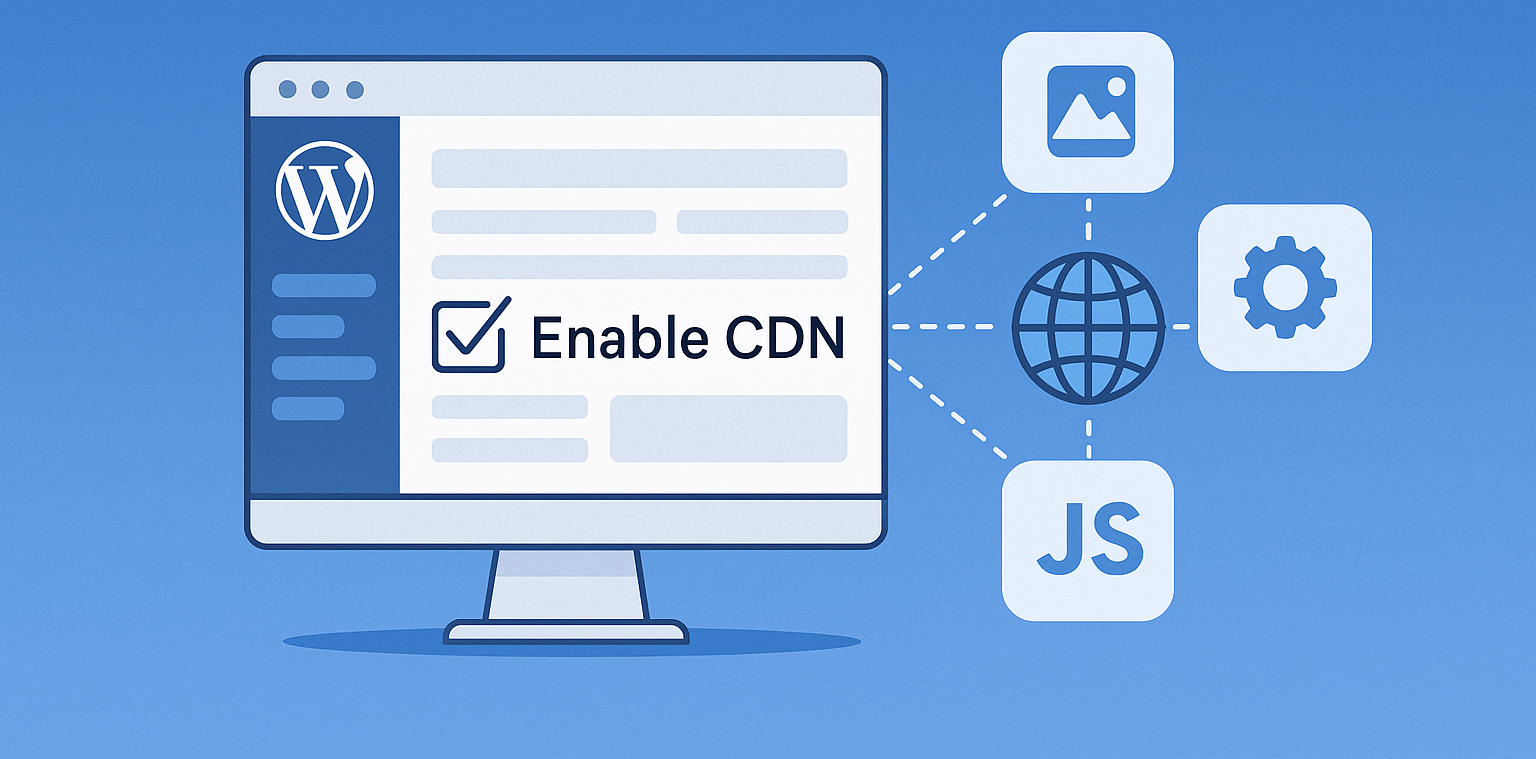If your WordPress website feels slow, you’re not alone. Page speed is a critical factor for SEO, user experience, and conversions in 2025. One of the most effective ways to speed up your site is by using a Content Delivery Network (CDN).
In this guide, you’ll learn:
- What a CDN is and how it works.
- Benefits of enabling a CDN in WordPress.
- Step-by-step method to enable a CDN from the WordPress Admin.
- Example setups for both image and static file delivery.
- Bonus: Code snippets for advanced customization.
What is a CDN?
A Content Delivery Network (CDN) is a network of servers distributed across the globe. Instead of loading your website files from one hosting server, a CDN stores cached versions of them in multiple locations.
When a visitor opens your site, the CDN delivers the files from the nearest server — resulting in faster load times.
Common files served by a CDN include:
- Images (JPG, PNG, WebP)
- CSS and JavaScript files
- Fonts
- Static HTML
Benefits of Using a CDN in WordPress
✅ Faster Website Load Times – Files are delivered from the closest server to the visitor.
✅ Better SEO Rankings – Google considers page speed in its ranking algorithm.
✅ Lower Hosting Costs – CDNs reduce bandwidth usage on your hosting server.
✅ Improved Security – Many CDNs offer DDoS protection and SSL.
✅ Higher Conversions – Faster websites reduce bounce rates.
How to Enable CDN in WordPress (Step-by-Step)
Step 1: Choose a CDN Provider
Popular CDN providers for WordPress include:
- Cloudflare (free + paid plans)
- Bunny.net (pay-as-you-go)
- KeyCDN
- Amazon CloudFront
- Fastly
Step 2: Get Your CDN URL
Once you’ve set up your CDN account, you’ll get a base URL — something like:
https://cdn.yourdomain.com
https://static.yourdomain.com
https://images.yourcdnprovider.net
Step 3: Install a CDN Plugin in WordPress
To connect your WordPress site to the CDN, you can use:
- CDN Enabler (free)
- W3 Total Cache
- LiteSpeed Cache (if on LiteSpeed hosting)
Step 4: Configure CDN Settings in WordPress Admin
- Log in to your WordPress Admin.
- Go to Settings → CDN (or the plugin’s settings page).
- Enable CDN by checking the box.
- Enter your CDN Base URL for images, static files, or both.
- Save changes.
Advanced: Enable Multiple CDNs (Images + Static Files)
You can configure separate CDNs for images, static files, and even links.
Example:
- Image CDN Base URL:
https://img.yourcdn.com - Static CDN Base URL:
https://static.yourcdn.com - Link CDN Base URL:
https://links.yourcdn.com
Custom Code Method for Advanced Users
If you prefer not to use a plugin, add this snippet to your theme’s functions.php file:
<?php
// // ========== REGISTER CDN SETTINGS IN ADMIN ==========
// WP Admin → Settings → General, like this:
// ✅ Enable Image CDN
// 🖼 Image CDN Base URL → https://img.mywebsite.com
// ✅ Enable Static CDN
// 📦 Static CDN Base URL → https://static.mywebsite.com
// ✅ Enable Link CDN
// 🔗 Link CDN Base URL → https://origin.mywebsite.com
// ========== REGISTER CDN SETTINGS ==========
add_action('admin_init', function () {
// Image CDN
register_setting('general', 'enable_image_cdn', ['type' => 'boolean', 'default' => true]);
register_setting('general', 'cdn_image_base', ['type' => 'string', 'default' => 'https://img.mycdn.com']);
add_settings_field('enable_image_cdn', 'Enable Image CDN', function () {
echo '<input type="checkbox" name="enable_image_cdn" value="1"' . checked(1, get_option('enable_image_cdn'), false) . '> Enable';
}, 'general');
add_settings_field('cdn_image_base', 'Image CDN Base URL', function () {
echo '<input type="url" name="cdn_image_base" value="' . esc_attr(get_option('cdn_image_base')) . '" class="regular-text">';
}, 'general');
// Static CDN
register_setting('general', 'enable_static_cdn', ['type' => 'boolean', 'default' => true]);
register_setting('general', 'cdn_static_base', ['type' => 'string', 'default' => 'https://static.mycdn.com']);
add_settings_field('enable_static_cdn', 'Enable Static CDN (CSS, JS, Fonts)', function () {
echo '<input type="checkbox" name="enable_static_cdn" value="1"' . checked(1, get_option('enable_static_cdn'), false) . '> Enable';
}, 'general');
add_settings_field('cdn_static_base', 'Static CDN Base URL', function () {
echo '<input type="url" name="cdn_static_base" value="' . esc_attr(get_option('cdn_static_base')) . '" class="regular-text">';
}, 'general');
// Link CDN
register_setting('general', 'enable_link_cdn', ['type' => 'boolean', 'default' => false]);
register_setting('general', 'cdn_link_base', ['type' => 'string', 'default' => 'https://mywebsite.com']);
add_settings_field('enable_link_cdn', 'Enable Link CDN (Page Links)', function () {
echo '<input type="checkbox" name="enable_link_cdn" value="1"' . checked(1, get_option('enable_link_cdn'), false) . '> Enable';
}, 'general');
add_settings_field('cdn_link_base', 'Link CDN Base URL', function () {
echo '<input type="url" name="cdn_link_base" value="' . esc_attr(get_option('cdn_link_base')) . '" class="regular-text">';
}, 'general');
});
// ========== MAIN CDN URL REPLACER ==========
function custom_cdn_url_replacer($url) {
if (is_admin() || defined('DOING_AJAX') || strpos($_SERVER['REQUEST_URI'], 'wp-login.php') !== false) {
return $url;
}
$origin = (is_ssl() ? 'https://' : 'http://') . $_SERVER['HTTP_HOST'];
$parsed_url = parse_url($url);
$path = $parsed_url['path'] ?? '';
// Image CDN
if (get_option('enable_image_cdn') && strpos($path, '/wp-content/uploads/') === 0) {
return str_replace($origin, get_option('cdn_image_base'), $url);
}
// Static CDN
$static_extensions = ['.css', '.js', '.woff', '.woff2', '.ttf', '.otf', '.eot', '.svg'];
if (get_option('enable_static_cdn')) {
foreach ($static_extensions as $ext) {
if (stripos($path, $ext) !== false) {
return str_replace($origin, get_option('cdn_static_base'), $url);
}
}
}
// Link CDN
if (get_option('enable_link_cdn')) {
return str_replace($origin, get_option('cdn_link_base'), $url);
}
return $url;
}
// ========== APPLY TO HOOKS ==========
add_filter('wp_get_attachment_url', 'custom_cdn_url_replacer');
add_filter('style_loader_src', 'custom_cdn_url_replacer');
add_filter('script_loader_src', 'custom_cdn_url_replacer');
add_filter('theme_file_uri', 'custom_cdn_url_replacer');
add_filter('template_directory_uri', 'custom_cdn_url_replacer');
// ========== APPLY TO CONTENT ==========
add_filter('the_content', function ($content) {
return custom_cdn_url_replacer($content);
});
add_filter('widget_text', 'custom_cdn_url_replacer');
add_filter('pagelayer_content', 'custom_cdn_url_replacer');
// ========== RTL SUPPORT ==========
add_filter('locale_stylesheet_uri', function ($uri) {
if (empty($uri) && is_rtl() && file_exists(get_template_directory() . '/rtl.css')) {
$uri = get_template_directory_uri() . '/rtl.css';
}
return $uri;
});
// ========== FINAL HTML OUTPUT REPLACEMENT ==========
add_action('template_redirect', function () {
if (!is_admin()) {
ob_start('replace_links_in_final_output');
}
});
function replace_links_in_final_output($buffer) {
$origin = (is_ssl() ? 'https://' : 'http://') . $_SERVER['HTTP_HOST'];
$replacements = [];
// Image CDN
if (get_option('enable_image_cdn')) {
$replacements[$origin . '/wp-content/uploads/'] = rtrim(get_option('cdn_image_base'), '/') . '/wp-content/uploads/';
}
// Static CDN
if (get_option('enable_static_cdn')) {
$static_cdn = rtrim(get_option('cdn_static_base'), '/');
$replacements[$origin . '/wp-content/themes/'] = $static_cdn . '/wp-content/themes/';
$replacements[$origin . '/wp-includes/'] = $static_cdn . '/wp-includes/';
$replacements[$origin . '/wp-content/plugins/'] = $static_cdn . '/wp-content/plugins/';
}
// Link CDN
if (get_option('enable_link_cdn')) {
$replacements[$origin] = rtrim(get_option('cdn_link_base'), '/');
}
// Replace direct string matches
foreach ($replacements as $from => $to) {
$buffer = str_replace($from, $to, $buffer);
}
// BONUS: Replace font and asset URLs in inline CSS using regex
if (get_option('enable_static_cdn')) {
$pattern = '/url\((["\']?)(https?:\/\/' . preg_quote($_SERVER['HTTP_HOST'], '/') . '\/[^"\')]+)(["\']?)\)/i';
$buffer = preg_replace_callback($pattern, function ($matches) {
$cdn_url = custom_cdn_url_replacer($matches[2]);
return 'url(' . $matches[1] . $cdn_url . $matches[3] . ')';
}, $buffer);
}
return $buffer;
}Note: Replace https://cdn.yourdomain.com with your CDN URL.
Testing Your CDN Setup
Once enabled, test your site using:
- GTmetrix (https://gtmetrix.com)
- Google PageSpeed Insights (https://pagespeed.web.dev)
- Pingdom Tools (https://tools.pingdom.com)
If everything is configured correctly, your assets should load from the CDN URL instead of your hosting server.
Final Thoughts
Enabling a CDN in WordPress is one of the easiest ways to boost your site speed, SEO rankings, and user experience in 2025.
Whether you’re using Cloudflare, Bunny.net, KeyCDN, or any other provider, the process is simple:
- Get your CDN URL.
- Configure it in WordPress via a plugin or custom code.
- Test and monitor performance.
By following this guide, your WordPress site will load faster for visitors worldwide — and that means happier users and better rankings.
# WordPress CDN setup, enable CDN WordPress, WordPress speed optimization, image CDN, static file CDN, CDN for SEO, speed up WordPress site, WordPress performance 2025




